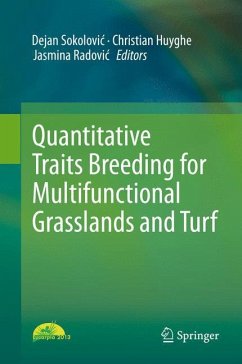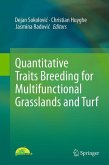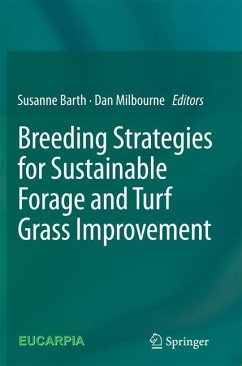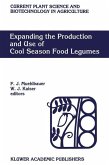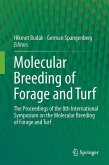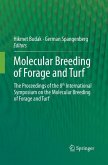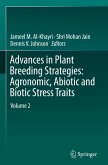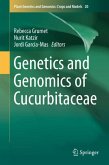Quantitative Traits Breeding for Multifunctional Grasslands and Turf
Herausgegeben:Sokolovic, Dejan; Huyghe, Christian; Radovic, Jasmina
Quantitative Traits Breeding for Multifunctional Grasslands and Turf
Herausgegeben:Sokolovic, Dejan; Huyghe, Christian; Radovic, Jasmina
- Gebundenes Buch
- Merkliste
- Auf die Merkliste
- Bewerten Bewerten
- Teilen
- Produkt teilen
- Produkterinnerung
- Produkterinnerung
Grasslands are among the largest ecosystems in the world and consequently are of great importance to mankind. The genotypes of the species which are the main components of the grasslands have great influence on total outcome and successful utilization of grasslands. Therefore fodder crops and turf swards should be constantly improved to follow modern trends in agriculture production and landscape architecture. The wide range of breeding programs for forage and amenity species, as well as new breeding methods and techniques, is rapidly expanding the boundaries and is making it possible to…mehr
Andere Kunden interessierten sich auch für
![Quantitative Traits Breeding for Multifunctional Grasslands and Turf Quantitative Traits Breeding for Multifunctional Grasslands and Turf]() Quantitative Traits Breeding for Multifunctional Grasslands and Turf161,99 €
Quantitative Traits Breeding for Multifunctional Grasslands and Turf161,99 €![Breeding strategies for sustainable forage and turf grass improvement Breeding strategies for sustainable forage and turf grass improvement]() Breeding strategies for sustainable forage and turf grass improvement121,99 €
Breeding strategies for sustainable forage and turf grass improvement121,99 €![Expanding the Production and Use of Cool Season Food Legumes Expanding the Production and Use of Cool Season Food Legumes]() Expanding the Production and Use of Cool Season Food Legumes42,99 €
Expanding the Production and Use of Cool Season Food Legumes42,99 €![Molecular Breeding of Forage and Turf Molecular Breeding of Forage and Turf]() Molecular Breeding of Forage and Turf121,99 €
Molecular Breeding of Forage and Turf121,99 €![Molecular Breeding of Forage and Turf Molecular Breeding of Forage and Turf]() Molecular Breeding of Forage and Turf121,99 €
Molecular Breeding of Forage and Turf121,99 €![Advances in Plant Breeding Strategies: Agronomic, Abiotic and Biotic Stress Traits Advances in Plant Breeding Strategies: Agronomic, Abiotic and Biotic Stress Traits]() Advances in Plant Breeding Strategies: Agronomic, Abiotic and Biotic Stress Traits178,99 €
Advances in Plant Breeding Strategies: Agronomic, Abiotic and Biotic Stress Traits178,99 €![Genetics and Genomics of Cucurbitaceae Genetics and Genomics of Cucurbitaceae]() Genetics and Genomics of Cucurbitaceae145,99 €
Genetics and Genomics of Cucurbitaceae145,99 €-
-
-
Grasslands are among the largest ecosystems in the world and consequently are of great importance to mankind. The genotypes of the species which are the main components of the grasslands have great influence on total outcome and successful utilization of grasslands. Therefore fodder crops and turf swards should be constantly improved to follow modern trends in agriculture production and landscape architecture. The wide range of breeding programs for forage and amenity species, as well as new breeding methods and techniques, is rapidly expanding the boundaries and is making it possible to achieve outstanding breeding results. This book includes papers presented at the 30 th EUCARPIA Fodder Crops and Amenity Grasses Section Meeting. The challenging title of the book focuses on breeding of quantitative traits, which directly impact the profitability and sustainability of grasslands and fodder crops production, as well as on multidisciplinary approach in grassland research and utilisation. Included papers offer a unique collection of ideas and breakthroughs in the fields of fodder crops and amenity grasses breeding and genetics, as well as in the creative and innovative application of new tools in practical breeding.
Produktdetails
- Produktdetails
- Verlag: Springer / Springer Netherlands
- Artikelnr. des Verlages: 978-94-017-9043-7
- 2014
- Seitenzahl: 412
- Erscheinungstermin: 25. September 2014
- Englisch
- Abmessung: 241mm x 160mm x 28mm
- Gewicht: 800g
- ISBN-13: 9789401790437
- ISBN-10: 9401790434
- Artikelnr.: 40669599
- Herstellerkennzeichnung Die Herstellerinformationen sind derzeit nicht verfügbar.
- Verlag: Springer / Springer Netherlands
- Artikelnr. des Verlages: 978-94-017-9043-7
- 2014
- Seitenzahl: 412
- Erscheinungstermin: 25. September 2014
- Englisch
- Abmessung: 241mm x 160mm x 28mm
- Gewicht: 800g
- ISBN-13: 9789401790437
- ISBN-10: 9401790434
- Artikelnr.: 40669599
- Herstellerkennzeichnung Die Herstellerinformationen sind derzeit nicht verfügbar.
Preface.- Part 1. Introduction. 1. Forage and grasslands in a sustainable agriculture: new challenges for breeding; Christian Huyghe, Charles Brummer.- 2. Agriculture, forage crops and grasslands in Serbia: production and breeding; Dejan Sokolovic et al.- Part 2. Genetic diversity among and within species. 3. Ex situ conservation of genetic resources of forage and turf species in the IPK Gene bank at Malchow; Evelin Willner, K.J. Dehmer.- 4. Genetic response to climate scenarios in Dactylis and Festuca of temperate vs Mediterranean origin; Mark Ghesquière et al.- 5. Monitoring of vegetation changes in selected sinkholes in the Moravian karst, Czech Republic; Tomás Vymyslický, Zdenek Musil.- 6. Evaluation of a diverse collection of red clover germplasm for susceptibility to clover rot (Sclerotinia trifoliorum) and other important traits; Tim Vleugels et al.- 7. Variability of alsike clover (Trifolium hybridum L.) natural populations from Serbia; Mirjana Petrovic et al.- 8. Characterization of some local populations of Medicago minima collected in the Central Steppe of Algeria; Abderrezak Chebouti et al.- 9. Genetic variability of the most important traits in meadow fescue accessions; Snezana Babic et al.- 10. Morphological variation between perennial ryegrass (Lolium perenne L.) natural ecotypes; Vilma Kemesyt et al.- 11. Variability of selected traits in the Czech alfalfa core collection; Jan Pelikán et al.- 12. Influence of management and habitat on genotypic and phenotypic diversity of Dactylis glomerata; Luisa Last et al.- 13. The utilisation of wild Fabaceae species in grasslands; Daniela Knotová et al.- 14. Assessment of susceptibility of different alfalfa genotypes to Colletotrichum destructivum; Tanja Vasic et al.- 15. TheCzech core collection of Medicago spp.; Tomás Vymyslický et al.- Part 3. Practical breeding of fodder crops. 16. Variation in cell wall digestibility of perennial ryegrass at heading stage; Frederik van Parijs et al.- 17. Factors influencing animal preference of tall fescue genotypes; Mathias Cougnon et al.- 18. Fair evaluation of yield potential in forage species evaluation; Ulf Feuerstein, Anita Swieter.- 19. Patterns of morphophysiological diversity and their implications for selection of grazing-tolerant Lucerne; Luciano Pecetti et al.- 20. Combining abilities of different alfalfa (Medicago sativa L.) varieties; Jasmina Radovic et al.- 21. Towards productive summer dormant cocksfoot for Mediterranean climates; Philippe Barre et al.- 22. Potential of some neglected European annual legume crops for forage production; Aleksandar Mikic, V. Mihailovic.- 23. New insights into alfalfa forage quality through the research project Qual&Medica; Marilena Paolini et al.- 24. Certain aspects of breeding forage brassicas; Aleksandar Mikic et al.- 25. Evaluation of dormancy and winter hardiness of alfalfa (Medicago sativa L.) experimental lines, obtained by crossing parental lines characterized within the framework of the PERMED project; Valentina Nanni et al.- 26. Breeding perennial ryegrass with enhanced water soluble carbohydrate content; An Ghesquiere, J. Baert.- 27. Resistance of perennial ryegrass to crown and stem rust under field and greenhouse conditions; Radek Machác, Bohumir Cagas.- 28. Ideotypes of forage pea (Pisum sativum) cultivars; Vojislav Mihailovic, A. Mikic.- Part 4. Turf grass breeding. 29. Recent achievements in breeding for turf quality under biotic and abiotic stress; Trygve Aamlid, Vinsent Gensollen.- 30. Evaluation of grass species cultivars and mixturesfor use in high quality lawn tennis courts; Andy Newell.- Part 5. New biotechnology methods in sustainable breeding: strategies and implementation. 31. Characterisation of genetic diversity for resistance and quality traits using molecular tools; Hilde Muylle et al.- 32. Genome sequencing of model and forage legume species: consequences for genetic studies; Bernadette Julier et al.- 33. A genetic association between leaf elongation rate and flowering time in perennial ryegrass; Daniel Thorogood et al.- 34. Inheritance of crown rust resistance in a perennial ryegrass genotype of the cultivar Arvella; Franz Xaver Schubiger, B. Boller.- 35. High density array for SNP genotyping and mapping in tetraploid alfalfa; Yuanhong Han et al.- 36. Variation of cell wall digestibility in fodder grasses with particular focus on a perennial ryegrass breeding pool; Jost Baert et al.- 37. QTL identification for leaf senescence in perennial ryegrass (Lolium perenne L.); Meraluna Canunayon, Daniel Thorogood.- 38. Validation of candidate genes expression profiles during cold acclimation and freezing in perennial ryegrass; Kristina Jonavicien et al.- 39. Different aspects of shoot branching in red clover; Annemie Van Minnebruggen et al.- 40. AFLP analysis of genetic diversity in an association mapping panel of Lolium perenne L.; Grazina Statkeviciut et al.- 41. Allele frequency of local maize inbred lines (Zea mays L.); Jasmina Milenkovic et al.- Part 6. Breeding for new roles of multifunctional forage species. 42. Breeding for 'HealthyHay': Can we optimise plant polyphenols in legumes for ruminant nutrition, animal health and environmental sustainability?; Irene Mueller-Harvey.- 43. High-throughput genome-wide genotyping to revive the use of natural diversity in forage and turf breeding;Jean Paul Sampoux et al.- 44. Monitoring, analysis and modeling of yield and quality dynamics of Lolium perenne varieties for biogas production; Anita Swieter et al.- 45. Effects of rhizobacterial inoculation of a preceding oat crop on alfalfa (Medicago sativa L.) yield; Dusica Delic et al.- 46. Phalaris arundinacea L.: Variations in seed shattering and related traits in a breeding collection; Karin Förster et al.- 47. Effect of alfalfa cultivar on pollinator visitation, seed yield and yield components; Goran Jevtic et al.- 48. The influence of individual and combined inoculants on development of alfalfa on acidic soil; Snezana Andjelkovic et al.- 49. Alfalfa genetic variation for biomass production in pure and mixed stands; Amel Maamouri et al.- Part 7. Forage and seed production. 50. Drought effect on yield of perennial ryegrass (Lolium perenne L.); Jonas Aper et al.- 51. Optimising stand density and nitrogen fertiliser rates for seed production in the tetraploid Italian ryegrass cultivar K29T; Aleksandar Simic et al.- 52. The influence of climatic conditions on forage yield and quality of certain types of grass; Tihomir Cupic et al.- 53. Indicating soil quality using urease and saccharase activity in abandoned grassland and differently managed crop fields; Ligita Balezentien .
Preface.- Part 1. Introduction. 1. Forage and grasslands in a sustainable agriculture: new challenges for breeding; Christian Huyghe, Charles Brummer.- 2. Agriculture, forage crops and grasslands in Serbia: production and breeding; Dejan Sokolovic et al.- Part 2. Genetic diversity among and within species. 3. Ex situ conservation of genetic resources of forage and turf species in the IPK Gene bank at Malchow; Evelin Willner, K.J. Dehmer.- 4. Genetic response to climate scenarios in Dactylis and Festuca of temperate vs Mediterranean origin; Mark Ghesquière et al.- 5. Monitoring of vegetation changes in selected sinkholes in the Moravian karst, Czech Republic; Tomás Vymyslický, Zdenek Musil.- 6. Evaluation of a diverse collection of red clover germplasm for susceptibility to clover rot (Sclerotinia trifoliorum) and other important traits; Tim Vleugels et al.- 7. Variability of alsike clover (Trifolium hybridum L.) natural populations from Serbia; Mirjana Petrovic et al.- 8. Characterization of some local populations of Medicago minima collected in the Central Steppe of Algeria; Abderrezak Chebouti et al.- 9. Genetic variability of the most important traits in meadow fescue accessions; Snezana Babic et al.- 10. Morphological variation between perennial ryegrass (Lolium perenne L.) natural ecotypes; Vilma Kemesyt et al.- 11. Variability of selected traits in the Czech alfalfa core collection; Jan Pelikán et al.- 12. Influence of management and habitat on genotypic and phenotypic diversity of Dactylis glomerata; Luisa Last et al.- 13. The utilisation of wild Fabaceae species in grasslands; Daniela Knotová et al.- 14. Assessment of susceptibility of different alfalfa genotypes to Colletotrichum destructivum; Tanja Vasic et al.- 15. TheCzech core collection of Medicago spp.; Tomás Vymyslický et al.- Part 3. Practical breeding of fodder crops. 16. Variation in cell wall digestibility of perennial ryegrass at heading stage; Frederik van Parijs et al.- 17. Factors influencing animal preference of tall fescue genotypes; Mathias Cougnon et al.- 18. Fair evaluation of yield potential in forage species evaluation; Ulf Feuerstein, Anita Swieter.- 19. Patterns of morphophysiological diversity and their implications for selection of grazing-tolerant Lucerne; Luciano Pecetti et al.- 20. Combining abilities of different alfalfa (Medicago sativa L.) varieties; Jasmina Radovic et al.- 21. Towards productive summer dormant cocksfoot for Mediterranean climates; Philippe Barre et al.- 22. Potential of some neglected European annual legume crops for forage production; Aleksandar Mikic, V. Mihailovic.- 23. New insights into alfalfa forage quality through the research project Qual&Medica; Marilena Paolini et al.- 24. Certain aspects of breeding forage brassicas; Aleksandar Mikic et al.- 25. Evaluation of dormancy and winter hardiness of alfalfa (Medicago sativa L.) experimental lines, obtained by crossing parental lines characterized within the framework of the PERMED project; Valentina Nanni et al.- 26. Breeding perennial ryegrass with enhanced water soluble carbohydrate content; An Ghesquiere, J. Baert.- 27. Resistance of perennial ryegrass to crown and stem rust under field and greenhouse conditions; Radek Machác, Bohumir Cagas.- 28. Ideotypes of forage pea (Pisum sativum) cultivars; Vojislav Mihailovic, A. Mikic.- Part 4. Turf grass breeding. 29. Recent achievements in breeding for turf quality under biotic and abiotic stress; Trygve Aamlid, Vinsent Gensollen.- 30. Evaluation of grass species cultivars and mixturesfor use in high quality lawn tennis courts; Andy Newell.- Part 5. New biotechnology methods in sustainable breeding: strategies and implementation. 31. Characterisation of genetic diversity for resistance and quality traits using molecular tools; Hilde Muylle et al.- 32. Genome sequencing of model and forage legume species: consequences for genetic studies; Bernadette Julier et al.- 33. A genetic association between leaf elongation rate and flowering time in perennial ryegrass; Daniel Thorogood et al.- 34. Inheritance of crown rust resistance in a perennial ryegrass genotype of the cultivar Arvella; Franz Xaver Schubiger, B. Boller.- 35. High density array for SNP genotyping and mapping in tetraploid alfalfa; Yuanhong Han et al.- 36. Variation of cell wall digestibility in fodder grasses with particular focus on a perennial ryegrass breeding pool; Jost Baert et al.- 37. QTL identification for leaf senescence in perennial ryegrass (Lolium perenne L.); Meraluna Canunayon, Daniel Thorogood.- 38. Validation of candidate genes expression profiles during cold acclimation and freezing in perennial ryegrass; Kristina Jonavicien et al.- 39. Different aspects of shoot branching in red clover; Annemie Van Minnebruggen et al.- 40. AFLP analysis of genetic diversity in an association mapping panel of Lolium perenne L.; Grazina Statkeviciut et al.- 41. Allele frequency of local maize inbred lines (Zea mays L.); Jasmina Milenkovic et al.- Part 6. Breeding for new roles of multifunctional forage species. 42. Breeding for 'HealthyHay': Can we optimise plant polyphenols in legumes for ruminant nutrition, animal health and environmental sustainability?; Irene Mueller-Harvey.- 43. High-throughput genome-wide genotyping to revive the use of natural diversity in forage and turf breeding;Jean Paul Sampoux et al.- 44. Monitoring, analysis and modeling of yield and quality dynamics of Lolium perenne varieties for biogas production; Anita Swieter et al.- 45. Effects of rhizobacterial inoculation of a preceding oat crop on alfalfa (Medicago sativa L.) yield; Dusica Delic et al.- 46. Phalaris arundinacea L.: Variations in seed shattering and related traits in a breeding collection; Karin Förster et al.- 47. Effect of alfalfa cultivar on pollinator visitation, seed yield and yield components; Goran Jevtic et al.- 48. The influence of individual and combined inoculants on development of alfalfa on acidic soil; Snezana Andjelkovic et al.- 49. Alfalfa genetic variation for biomass production in pure and mixed stands; Amel Maamouri et al.- Part 7. Forage and seed production. 50. Drought effect on yield of perennial ryegrass (Lolium perenne L.); Jonas Aper et al.- 51. Optimising stand density and nitrogen fertiliser rates for seed production in the tetraploid Italian ryegrass cultivar K29T; Aleksandar Simic et al.- 52. The influence of climatic conditions on forage yield and quality of certain types of grass; Tihomir Cupic et al.- 53. Indicating soil quality using urease and saccharase activity in abandoned grassland and differently managed crop fields; Ligita Balezentien .

